World Roundup
January/February 2015


-
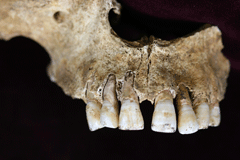 TENNESSEE: In 1989, just before the Nashville Zoo was constructed, archaeologists at the site found an undocumented cemetery, which was left undisturbed. Speculation was that the graves could belong to tenant farmers or a community of slaves. Plans were recently made to expand the zoo and relocate the cemetery, which provided anthropologists a chance to learn more about who was buried there. Analysis of the 19 graves excavated revealed African cranial traits and DNA, evidence of hard labor, and artifacts dating to the mid-19th century—indications of a slave cemetery. —Samir S. Patel
TENNESSEE: In 1989, just before the Nashville Zoo was constructed, archaeologists at the site found an undocumented cemetery, which was left undisturbed. Speculation was that the graves could belong to tenant farmers or a community of slaves. Plans were recently made to expand the zoo and relocate the cemetery, which provided anthropologists a chance to learn more about who was buried there. Analysis of the 19 graves excavated revealed African cranial traits and DNA, evidence of hard labor, and artifacts dating to the mid-19th century—indications of a slave cemetery. —Samir S. Patel -
 UTAH: Rock art can be notoriously difficult to date, so theories about the age of the dozens of enigmatic figures painted in the Great Gallery in Horseshoe Canyon are predictably wide-ranging—from 500 to 8,000 years old. Geoscientists recently used a technique called luminescence dating to determine that the paintings’ actual age is between 1,000 and 2,000 years old. The new dating creates fresh questions about the people who made the images. —Samir S. Patel
UTAH: Rock art can be notoriously difficult to date, so theories about the age of the dozens of enigmatic figures painted in the Great Gallery in Horseshoe Canyon are predictably wide-ranging—from 500 to 8,000 years old. Geoscientists recently used a technique called luminescence dating to determine that the paintings’ actual age is between 1,000 and 2,000 years old. The new dating creates fresh questions about the people who made the images. —Samir S. Patel -
 MEXICO: The ancient city of Teotihuacan relied heavily on maize, but the crop is low in certain nutrients, and frost and drought make it risky to cultivate. Paintings and artifacts suggest that people also turned to pulque, an alcoholic beverage made from agave sap, to fill nutritional needs, especially during maize shortages. But until now, there was no direct evidence of it. A new study has successfully found on potsherds not traces of pulque, but of compounds produced by Zymomonas mobilis, the bacterium used in its fermentation. —Samir S. Patel
MEXICO: The ancient city of Teotihuacan relied heavily on maize, but the crop is low in certain nutrients, and frost and drought make it risky to cultivate. Paintings and artifacts suggest that people also turned to pulque, an alcoholic beverage made from agave sap, to fill nutritional needs, especially during maize shortages. But until now, there was no direct evidence of it. A new study has successfully found on potsherds not traces of pulque, but of compounds produced by Zymomonas mobilis, the bacterium used in its fermentation. —Samir S. Patel -
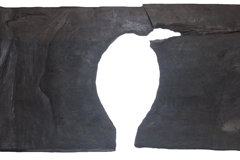 ENGLAND: In the ongoing excavations of Vindolanda, one of the northernmost Roman forts, near Hadrian’s Wall, excavators found a wooden toilet seat. Marble and stone seats have been found in other parts of the Roman world, but this is thought to be the only surviving wooden one. The 2,000-year-old bench appears to have been well used and, researchers report, rather comfortable. —Samir S. Patel
ENGLAND: In the ongoing excavations of Vindolanda, one of the northernmost Roman forts, near Hadrian’s Wall, excavators found a wooden toilet seat. Marble and stone seats have been found in other parts of the Roman world, but this is thought to be the only surviving wooden one. The 2,000-year-old bench appears to have been well used and, researchers report, rather comfortable. —Samir S. Patel -
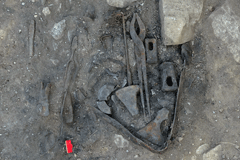 NORWAY: A man removing some pesky flagstones from his yard stumbled across a pair of metal tongs—and then a bent sword. Luckily, he called in archaeologists, who excavated the grave of a Viking blacksmith, probably dating to the late 8th century. In all, some 200 objects have emerged from the site, including smithing tools such as three hammers, two anvils, ember tongs, and a fire rake, as well as products of his labor, such as an ax, arrows, and a knife. The range of finds suggests he was an important local craftsman.
NORWAY: A man removing some pesky flagstones from his yard stumbled across a pair of metal tongs—and then a bent sword. Luckily, he called in archaeologists, who excavated the grave of a Viking blacksmith, probably dating to the late 8th century. In all, some 200 objects have emerged from the site, including smithing tools such as three hammers, two anvils, ember tongs, and a fire rake, as well as products of his labor, such as an ax, arrows, and a knife. The range of finds suggests he was an important local craftsman. -
 SPAIN: According to historical sources, the site from which Christopher Columbus set sail in 1492, Palos de la Frontera, had a pottery works and a building that served as an office, store, tavern, and inn for sailors. Though its location had been inferred, the specific site and components of the port had been lost until recent work there revealed pottery ovens and sherds and the remains of that multiuse building. It was most likely a site where Columbus made some arrangements for the historic voyage to the New World. —Samir S. Patel
SPAIN: According to historical sources, the site from which Christopher Columbus set sail in 1492, Palos de la Frontera, had a pottery works and a building that served as an office, store, tavern, and inn for sailors. Though its location had been inferred, the specific site and components of the port had been lost until recent work there revealed pottery ovens and sherds and the remains of that multiuse building. It was most likely a site where Columbus made some arrangements for the historic voyage to the New World. —Samir S. Patel -
 SICILY: Countless piles of amphoras from ancient shipwrecks lie scattered throughout the Mediterranean. So there’s nothing very unusual about a particular 2,000-year-old pile 420 feet below the waters of the Aeolian Islands, except for an unexpected find in the ship’s bow—a thymiaterion, or an incense burner, consisting of a bowl atop a column. It represents rare evidence confirming historical accounts that ancient sailors conducted rituals at sea, including when leaving or entering a harbor or in times of distress. —Samir S. Patel
SICILY: Countless piles of amphoras from ancient shipwrecks lie scattered throughout the Mediterranean. So there’s nothing very unusual about a particular 2,000-year-old pile 420 feet below the waters of the Aeolian Islands, except for an unexpected find in the ship’s bow—a thymiaterion, or an incense burner, consisting of a bowl atop a column. It represents rare evidence confirming historical accounts that ancient sailors conducted rituals at sea, including when leaving or entering a harbor or in times of distress. —Samir S. Patel -
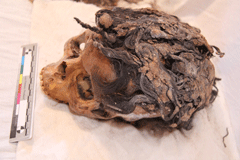 EGYPT: In a study of more than 100 skulls excavated from the site of Amarna, some 28 had remains of preserved hair, which is allowing a unique look into hairstyles and ethnicity in this part of ancient Egypt 3,300 years ago. Among them were several with extensions braided into the natural hair, including one on which there were approximately 70 extensions fastened in different places and layers. —Samir S. Patel
EGYPT: In a study of more than 100 skulls excavated from the site of Amarna, some 28 had remains of preserved hair, which is allowing a unique look into hairstyles and ethnicity in this part of ancient Egypt 3,300 years ago. Among them were several with extensions braided into the natural hair, including one on which there were approximately 70 extensions fastened in different places and layers. —Samir S. Patel -
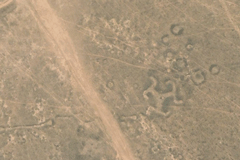 KAZAKHSTAN: Using Google Earth and satellite imagery, scientists have recently found some 50 geoglyphs, some up to a quarter-mile across, made up of patterns of discrete mounds, in the northern steppes. Excavations, remote sensing, and other studies are under way. It appears there are no structures buried within the mounds, and the purpose of the enigmatic earthworks remains unknown. They may help track early human migration across the region. —Samir S. Patel
KAZAKHSTAN: Using Google Earth and satellite imagery, scientists have recently found some 50 geoglyphs, some up to a quarter-mile across, made up of patterns of discrete mounds, in the northern steppes. Excavations, remote sensing, and other studies are under way. It appears there are no structures buried within the mounds, and the purpose of the enigmatic earthworks remains unknown. They may help track early human migration across the region. —Samir S. Patel -
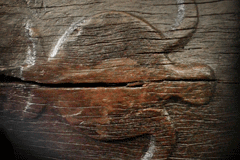 NEW ZEALAND: Following a storm, a large piece of a 600-year-old canoe emerged from a beach on South Island. Now undergoing conservation and study, the canoe suggests connections with places across the South Pacific. It is made of local black pine, but employs a sophisticated oceangoing design with ribs and a girder, and has a carving of a turtle on the hull. Both the design and carving were unknown or rare in New Zealand at the time, and represent some sort of cultural continuity with the rest of Polynesia. —Samir S. Patel
NEW ZEALAND: Following a storm, a large piece of a 600-year-old canoe emerged from a beach on South Island. Now undergoing conservation and study, the canoe suggests connections with places across the South Pacific. It is made of local black pine, but employs a sophisticated oceangoing design with ribs and a girder, and has a carving of a turtle on the hull. Both the design and carving were unknown or rare in New Zealand at the time, and represent some sort of cultural continuity with the rest of Polynesia. —Samir S. Patel
Advertisement
IN THIS ISSUE
Trenches
The Price of Plunder
Off The Grid
A Tale of Two Railroads
On the Origins of Art
Fancy Footwear
The King is Dead. Long Live the King
Cults of the Bronze Age
Symbolic Neanderthals
Hollywood Exodus
Egypt's Disappearing Animals
Across the Atlantic by Flipper
Viking Treasure Trove
Paleo-escargot
Maya Cities Lost and Found
Advertisement

Recent Issues
-
 May/June 2024
May/June 2024
-
 March/April 2024
March/April 2024
-
 January/February 2024
January/February 2024
-
 November/December 2023
November/December 2023
-
 September/October 2023
September/October 2023
-
 July/August 2023
July/August 2023
-
 May/June 2023
May/June 2023
-
 March/April 2023
March/April 2023
-
 January/February 2023
January/February 2023
-
 November/December 2022
November/December 2022
-
 September/October 2022
September/October 2022
-
 July/August 2022
July/August 2022
-
 May/June 2022
May/June 2022
-
 March/April 2022
March/April 2022
-
 January/February 2022
January/February 2022
-
 November/December 2021
November/December 2021
-
 September/October 2021
September/October 2021
-
 July/August 2021
July/August 2021
-
 May/June 2021
May/June 2021
-
 March/April 2021
March/April 2021
-
 January/February 2021
January/February 2021
-
 November/December 2020
November/December 2020
-
 September/October 2020
September/October 2020
-
 July/August 2020
July/August 2020
-
 May/June 2020
May/June 2020
-
 March/April 2020
March/April 2020
-
 January/February 2020
January/February 2020
-
 November/December 2019
November/December 2019
-
 September/October 2019
September/October 2019
-
 July/August 2019
July/August 2019
-
 May/June 2019
May/June 2019
-
 March/April 2019
March/April 2019
-
 January/February 2019
January/February 2019
-
 November/December 2018
November/December 2018
-
 September/October 2018
September/October 2018
-
 July/August 2018
July/August 2018
-
 May/June 2018
May/June 2018
-
 March/April 2018
March/April 2018
-
 January/February 2018
January/February 2018
-
 November/December 2017
November/December 2017
-
 September/October 2017
September/October 2017
-
 July/August 2017
July/August 2017
-
 May/June 2017
May/June 2017
-
 March/April 2017
March/April 2017
-
 January/February 2017
January/February 2017
-
 November/December 2016
November/December 2016
-
 September/October 2016
September/October 2016
-
 July/August 2016
July/August 2016
-
 May/June 2016
May/June 2016
-
 March/April 2016
March/April 2016
-
 January/February 2016
January/February 2016
-
 November/December 2015
November/December 2015
-
 September/October 2015
September/October 2015
-
 July/August 2015
July/August 2015
-
 May/June 2015
May/June 2015
-
 March/April 2015
March/April 2015
-
 January/February 2015
January/February 2015
-
 November/December 2014
November/December 2014
-
 September/October 2014
September/October 2014
-
 July/August 2014
July/August 2014
-
 May/June 2014
May/June 2014
-
 March/April 2014
March/April 2014
-
 January/February 2014
January/February 2014
-
 November/December 2013
November/December 2013
-
 September/October 2013
September/October 2013
-
 July/August 2013
July/August 2013
-
 May/June 2013
May/June 2013
-
 March/April 2013
March/April 2013
-
 January/February 2013
January/February 2013
-
 November/December 2012
November/December 2012
-
 Sep/Oct 2012
Sep/Oct 2012
-
 September/October 2012
September/October 2012
-
 July/August 2012
July/August 2012
-
 May/June 2012
May/June 2012
-
 March/April 2012
March/April 2012
-
 January/February 2012
January/February 2012
-
 November/December 2011
November/December 2011
-
 September/October 2011
September/October 2011
-
 July/August 2011
July/August 2011
-
 May/June 2011
May/June 2011
-
 March/April 2011
March/April 2011
-
 January/February 2011
January/February 2011
Advertisement






